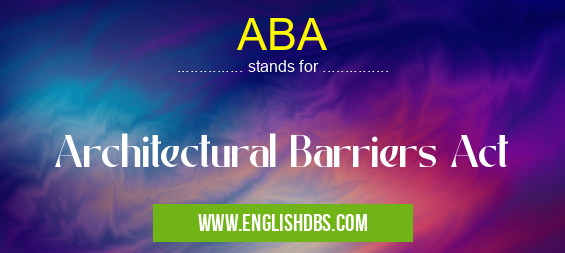What does ABA mean in LEGISLATION
The Architectural Barriers Act (ABA) is a United States federal law originally enacted in 1968 that requires buildings and facilities designed, constructed, or altered by Federal agencies to be accessible to persons with disabilities. The purpose of the ABA is to ensure that all people have the opportunity to participate fully in the activities of everyday life, regardless of physical ability. The ABA applies to any building or facility that receives funding from the Federal government as well as buildings or facilities leased by a Federal agency.

ABA meaning in Legislation in Governmental
ABA mostly used in an acronym Legislation in Category Governmental that means Architectural Barriers Act
Shorthand: ABA,
Full Form: Architectural Barriers Act
For more information of "Architectural Barriers Act", see the section below.
What Are The Requirements Under The ABA? The requirements under the ABA are broadly classified into two categories
structural changes and programmatic changes. Structural changes are those that involve alterations in design or construction such as adding ramps, elevators, wider doorways and other features that help people with disabilities enter a building more easily. Programmatic changes are those related to providing accessible services such as providing sign language interpreters at events or making sure that websites are usable for those with visual impairments. In order for a building or facility to be considered compliant under the ABA requirements it must meet both structural change and programmatic change requirements that relate specifically to disabled access.
Essential Questions and Answers on Architectural Barriers Act in "GOVERNMENTAL»LEGISLATION"
What is the Architectural Barriers Act (ABA)?
The Architectural Barriers Act of 1968 (ABA) is a federal law which requires the accessibility of all federally funded buildings to individuals with disabilities. It was enacted to ensure that physical structures constructed or altered with certain federal funds are made accessible to persons with disabilities in accordance with applicable standards.
Who does the ABA cover?
The ABA applies to buildings, facilities, and other structures which have been designed, constructed, or altered with the assistance of certain federal funding sources. This includes publicly-funded projects such as universities, hospitals, airports, courthouses, and government offices.
What do I need to know about ABA compliance?
All new and existing construction and alteration projects must meet applicable design requirements for accessibility as specified in standards promulgated by either the U.S. Department of Justice or the U.S Access Board's Title II regulations regarding State and Local Government Facilities. Additionally, all existing federally funded facilities must be made structurally safe and usable for individuals with disabilities within three years of enactment of the ABA in 1988.
Are there any related regulations?
Yes. The Americans With Disabilities Act (ADA) covers private entities not subject to ABA requirements whereas ABA applies only to those specifically mentioned above; however there are some overlap between both laws when it comes to their technical requirements for facilities under their respective coverage areas.
Who enforces the ABA?
U.S Department of Justice has administrative responsibility for enforcing the ABA while investigating complaints against agencies that fail to comply with its requirements., The U.S Access Board maintains responsibility for setting and making accessible design standards under this law through its ADA/AB Component Technical Assistance Program (CTAP).
How can people file a complaint if they think that their rights under this law have been violated?
Complaints may be filed directly with government agencies responsible for enforcing the ABA or via an online form provided by the Office for Civil Rights at https://www2.ed.gov/about/offices/list/ocr/complaintintro.html . Alternatively, Individuals seeking legal advice may contact an attorney in their State who specializes in civil rights laws like this one.
Is there any guidance available on how to achieve architectural barriers compliance?
Yes! The U.S Access Board publishes guidelines for design standards applicable under this law known as "Design Standards” which provide information on accessible designs where necessary elements like ramps, elevators etc are properly accommodated so disabled persons may access these facilities safely and conveniently . Designers should consult these guidelines while designing new buildings or modifying existing ones so they can anticipate which measures will be needed prior implementation.
Final Words:
In conclusion, the Architectural Barriers Act (ABA) is an important piece of legislation in American society which aims to create equality in access for people with disabilities by mandating certain critical accessibility standards for any building or facility created, renovated or leased by the Federal Government. These requirements involve both structural changes such as constructing wider doorways and ramps and programmatic changes such as providing disability-related services or making sure websites are easy for visually impaired users to read on their computers or mobile devices if necessary. Ultimately this allows all individuals with various types of disability access the same opportunities regardless of physical ability so they can fully participate in activities without any discrimination based on their physical makeup.
ABA also stands for: |
|
| All stands for ABA |
